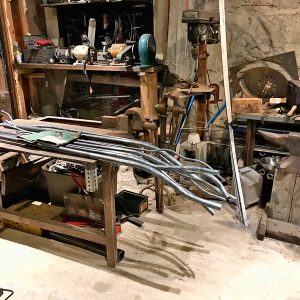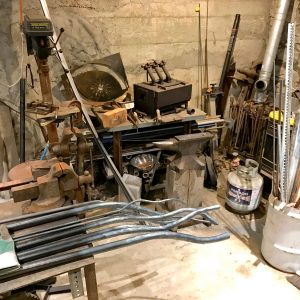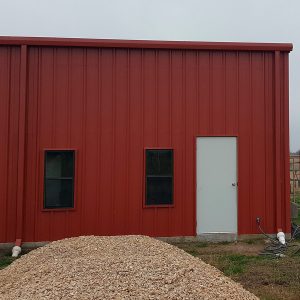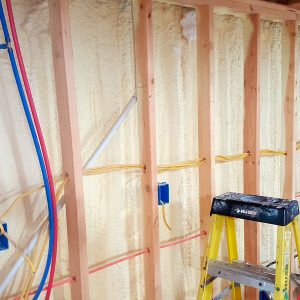Podcast Episode 166: Venting a Barndominium, Sealing Exterior End Grain, and Flashing Details for a Metal Roof
This week the editors attempt to answer several unique questions including "What's the best sealer for end cuts on decking?" and "Is there a reliable way to flash a masonry chimney to a standing-seam roof?"
Follow the Fine Homebuilding Podcast on your favorite app. Subscribe now and don’t miss an episode:
 |
 |
Patrick and Matt kick off the podcast by grilling Rob about his messy metal shop–but they all agree that (most) craftspeople need to have a ready supply of scrap materials at hand to feed their creative projects. Then it’s on to an assortment of listeners’ emails, with questions about ventilation requirements for a metal-clad, slab-on-grade home; the ideal product for protecting end grain on cedar and hemlock that will be exposed to the elements; and options for keeping water out of the gap between a chimney and a metal roof.
Editors’ updates:
Patrick and Matt have nothing new to report, but Rob shares some photos of a blacksmithing project he’s working on in his barn workshop. Of course, the guys spend more time talking about Rob’s cluttered shop than they do about metalwork.
 |
 |
Related links:
- Home-Energy Tracking in the Palm of Your Hand
- Sense.com: forum discussion about downloading and graphing energy data
News: Lowes employee attacks customer
Think twice before arguing with box-store employees. Patrick stumbled upon a news story about a store associate who lashed out when he was called out about his lack of knowledge about types of tile grout.
Question 1: What should provide the make-up air in a well-insulated barndominium?
Joseph writes: Hello, Enjoy the podcast. Thanks! I’m currently working on what’s called around here a barndominium (basically an apartment built inside the shell of a metal building). slab-on-grade foundation. Entire building envelope has 2 inches of continuous closed cell foam sprayed on the backside of the metal. See pics. Only two exterior doors and 5 windows, Mitsubishi mini splits, Panasonic ERV.
Haven’t done a blower door test but can’t imagine a tighter house.
My question: When the owner turns on the stove exhaust or bathroom exhaust what should provide the make-up air?
 |
 |
Related links:
- Insulating a Pole Barn
- The Passive House Build, Part Two: Air-Sealed Mudsill Assembly
- Airtight Drywall
Question 2: At what point do I need to consider an HRV or ERV when renovating an old home?
Matt writes: Hey, guys. Love the show and the magazine. I’ve learned so much from your content and have done a ton of work on my house as a result.
My question is: as an old house is renovated and becomes tighter, at what point should external ventilation (HRV/ERV) be added?
No clue how my 1967 house would perform on a blower door test, but I have air sealed a decent amount (attic, rim joist, downstairs renovation). Wondering at what point I need to consider fresh air. Thanks!
Related link:
Question 3: What works best for sealing cuts in exterior untreated wood (like hemlock or cedar)?
Blake from Northern Vermont writes: Hey all, I’d like to hear your opinions on products to seal end cuts. I bought anchor seal for the end cuts of a timber frame porch I built last summer on my place, I used it both on particularly vulnerable spots of the PT deck framing and the green hemlock posts. My father in law – a cabinet maker – insists that it’s useless since it’s wax based. He says it will eventually just evaporate. He prefers to soak the end cut in oil before installing.
I know there is a specific product for PT end cuts, but what do you guys think is best for untreated wood – like my green hemlock, or the cedar decking, or cedar siding? And what if primer isn’t an option because the wood will be stained with an oil-based stain and not painted? Just dunk it stain and move on with your day?
Thanks guys! Love the podcast!
Related links:
Question 4: How would you handle the flashing where a metal roof meets a chimney?
Andrew writes: Hello, I am considering re-doing the roof on my 1946 bungalow with screw down metal roofing. Metal roofing in the town of Plymouth, NH is not out of place and I am in favor of it for a few reasons, ease of application, affordable compared to standing seam and longevity compared to shingles. We all know the 30 year warranty on asphalt shingles is pointless and is lucky to last 20 years. The mounds of old shingles at transfer stations are also an environmental concern for me. There is the concern of leaking on the metal roof with penetrations but most houses don’t have a problem and replacing the screws in the next few decades is still easier than a new roof. I also have a theory that if the roof is steep enough the water will want to run off rather than want to work its way under rubber washer.
Anyways, my only hesitation with the metal roof is the chimney flashing. I have watched numerous youtube videos and it seems there are many methods out there and most rely heavily on sealant at the seams between the roofing and the flashing. Snow could accumulate behind chimney and wind driven precipitation could find its way behind flashing. I had an idea to run ice and water shield vertically on the roof deck near the chimney to add a waterproof barrier but there will always be a seam near the chimney.
Similar to some of you, my pockets and ego cannot deal with hiring a specialist.
How would you handle the flashing?
Related links:
 Keep Craft Alive Trucker Hat
Keep Craft Alive Trucker Hat
Support the trades! Buy a #KeepCraftAlive hat or t-shirt.
This episode of the podcast is brought to you by MiTek, ZipSystems, and Danner boots
This episode of the Fine Homebuilding Podcast is brought to you by MiTek for Breakthroughs in Building. MiTek offers integrated Solutions… for more affordable, sustainable, safe, healthy, efficient and resilient homes. As a diversified, global supplier of software, engineered structural connections, engineering services and automated manufacturing equipment, MiTek provides a technologically advanced, high-quality, and reliable approach to building better homes with better technology. Work with the industry leader to solve the labor shortage, reduce cycle times and eliminate waste.
Also brought to you by ZIP System building enclosures. With thirteen flashing tapes, stretch tapes, and liquid flashings that can be applied between zero and one hundred- and twenty-degrees Fahrenheit, ZIP System products offer a seam sealing solution for every twist and turn. Easily flash corners and curves, including door and window frames, pipe penetrations, and panel seams, using an enhanced acrylic formula. Find your flashing fit at your local lumberyard or Amazon dot com. ZIP System building enclosures – the fastest way to a tight, dry house.
Also brought to you by Danner boots. We’re not fortune tellers, but when you lace up our new Stronghold work boots, it’s easy to see that the future looks strong. We’re Danner, and after 85 years of making boots for the unforgiving Pacific Northwest… well, that means our boots come with deep roots. And the new Stronghold work boot is no exception. This is what happens when iconic quality runs into modern technology. You get tomorrow’s classic today. Get into the Stronghold for strength that starts right from where you stand. Find your local store at Danner.com.
We hope you will take advantage of a great offer for our podcast listeners: A special 20% off the discounted rate to subscribe to the Fine Homebuilding print magazine. That link goes to finehomebuilding.com/podoffer.
The show is driven by our listeners, so please subscribe and rate us on iTunes or Google Play, and if you have any questions you would like us to dig into for a future show, shoot an email our way: [email protected]. Also, be sure to follow Justin Fink and Fine Homebuilding on Instagram, and “like” the magazine on Facebook. Note that you can watch the show above, or on YouTube at the Fine Homebuilding YouTube Channel.
The Fine Homebuilding Podcast embodies Fine Homebuilding magazine’s commitment to the preservation of craftsmanship and the advancement of home performance in residential construction. The show is an informal but vigorous conversation about the techniques and principles that allow listeners to master their design and building challenges.
Other related links
- All FHB podcast show notes: FineHomebuilding.com/podcast.
- #KeepCraftAlive T-shirts support scholarships for building trades students. So go order some shirts at KeepCraftAlive.org.
- The direct link to the online store is here.


























